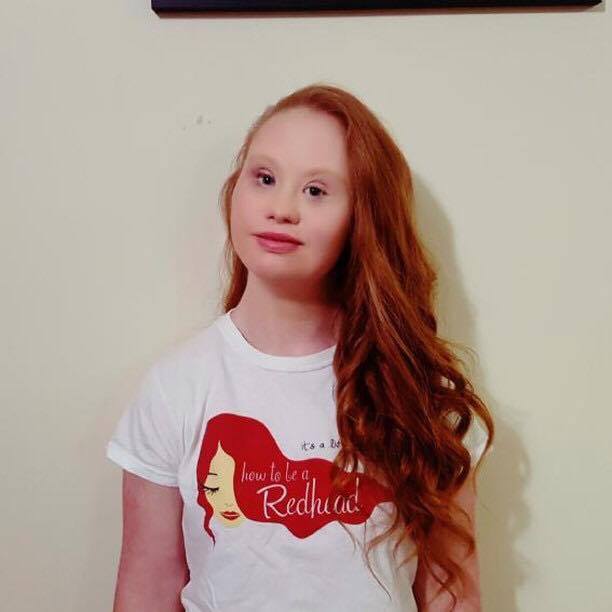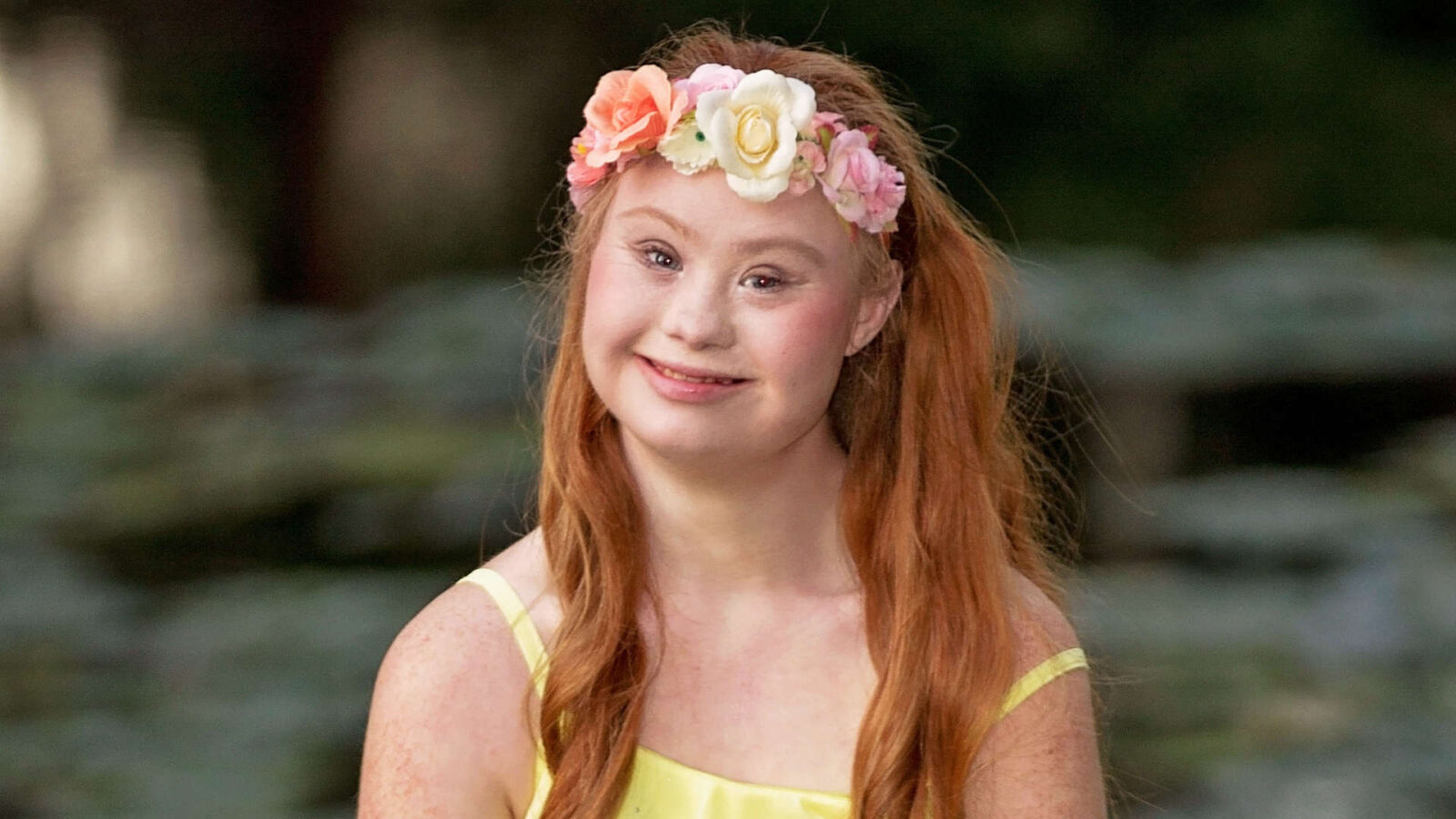Down Syndrome Redhead: Celebrating Uniqueness And Breaking Stereotypes
When you hear the term "down syndrome redhead," it may evoke curiosity, intrigue, or even a desire to understand more about this fascinating combination of characteristics. People with Down syndrome who also happen to have fiery red hair possess an extra layer of uniqueness that makes them stand out in the most beautiful way. Today, we're diving deep into this topic, exploring the science, stories, and significance behind this rare yet captivating combination.
Let’s be real for a sec, folks. The world has a way of putting people into boxes, but when you encounter someone with Down syndrome and red hair, those boxes suddenly feel a lot less important. These individuals remind us that diversity isn’t just skin-deep—it’s in every strand of hair, every smile, and every unique trait that makes someone who they are. And honestly, that’s something worth celebrating.
But why does it matter? Why should we care about Down syndrome redheads? Well, because they’re a living testament to the beauty of individuality. They challenge societal norms, break stereotypes, and remind us all that being different is not only okay—it’s amazing. So, buckle up, because we’re about to take a journey through the world of Down syndrome redheads, one fiery curl at a time.
Read also:Exploring Elon Musks Partners And Kids A Comprehensive Look
Here’s the deal: this article is jam-packed with info, stories, and insights that will leave you inspired. Whether you’re a parent, educator, or simply someone curious about the intersection of genetics and identity, you’re in the right place. Let’s get started!
Table of Contents
- What is Down Syndrome?
- The Genetics of Red Hair
- Biography: Stories of Down Syndrome Redheads
- Famous People with Down Syndrome and Red Hair
- Breaking Stereotypes: Redheads with Down Syndrome
- Building a Strong Support System
- Education and Empowerment
- The Importance of Community
- Health Considerations for Down Syndrome Redheads
- Celebrating Diversity and Inclusion
What is Down Syndrome?
Before we dive into the specifics of Down syndrome redheads, let’s take a step back and talk about what Down syndrome actually is. Simply put, Down syndrome is a genetic condition caused by an extra copy of chromosome 21. This extra chromosome affects physical and cognitive development, leading to a range of characteristics that vary from person to person. Some common traits include a flattened face, almond-shaped eyes, and a single palmar crease on the hand.
Now, here’s the thing: while Down syndrome can present challenges, it doesn’t define who someone is. People with Down syndrome are just as capable of love, joy, and success as anyone else. And when you add red hair to the mix? Well, let’s just say it’s a recipe for pure awesomeness.
Types of Down Syndrome
There are three main types of Down syndrome: trisomy 21, translocation Down syndrome, and mosaic Down syndrome. Trisomy 21 is the most common type, accounting for about 95% of cases. It occurs when there’s an extra copy of chromosome 21 in every cell of the body. Translocation Down syndrome happens when part of chromosome 21 attaches to another chromosome, while mosaic Down syndrome occurs when only some cells have the extra chromosome.
So, next time you meet someone with Down syndrome, remember that they’re not defined by their diagnosis. They’re individuals with their own strengths, talents, and quirks—and if they happen to have red hair, well, that’s just the cherry on top.
The Genetics of Red Hair
Alright, let’s talk about the other half of the equation: red hair. Did you know that redheads make up only about 1-2% of the global population? That’s right—being a redhead is pretty rare. And when you combine that with Down syndrome, you’re talking about an incredibly unique combination.
Read also:Ballistics And Document Analysis Crossword The Ultimate Guide For Puzzle Enthusiasts
Red hair is primarily caused by mutations in the MC1R gene, which is responsible for producing melanin, the pigment that gives our skin, hair, and eyes their color. People with red hair typically have a version of this gene that produces more pheomelanin (the pigment responsible for red tones) than eumelanin (the pigment responsible for darker tones). This results in that signature fiery hue we all know and love.
Red Hair and Genetic Diversity
But here’s the kicker: genetic diversity plays a huge role in the development of both Down syndrome and red hair. While Down syndrome is caused by an extra chromosome, red hair is influenced by specific genetic mutations. When these two factors come together, the result is a person who is truly one-of-a-kind.
Think about it this way: if genetics were a recipe, Down syndrome redheads would be the ultimate gourmet dish. Each ingredient—chromosome 21, the MC1R gene, and countless other factors—contributes to the final product: a person who is as unique as they come.
Biography: Stories of Down Syndrome Redheads
Now that we’ve covered the science, let’s dive into the stories. There are countless individuals with Down syndrome and red hair who are making waves in their communities and beyond. These are their stories, their struggles, and their triumphs.
Data and Biodata
Here’s a quick snapshot of some real-life Down syndrome redheads:
| Name | Age | Location | Hobbies |
|---|---|---|---|
| Sophie Thompson | 25 | London, UK | Painting, singing, and gardening |
| James Parker | 18 | Sydney, Australia | Playing guitar, hiking, and cooking |
| Emma Davis | 30 | Chicago, USA | Writing poetry, photography, and volunteering |
These individuals, and many others like them, remind us that labels don’t define who we are. They’re artists, musicians, and community leaders who happen to have Down syndrome and red hair. And honestly, that’s pretty darn cool.
Famous People with Down Syndrome and Red Hair
While there may not be a ton of famous Down syndrome redheads (yet!), there are certainly people with Down syndrome who have made a name for themselves in various fields. From actors to activists, these individuals are breaking barriers and inspiring others to do the same.
Meet Sarah Jane
Sarah Jane is a model and advocate who has been featured in numerous campaigns promoting inclusion and diversity. With her fiery red hair and infectious smile, she’s become a symbol of empowerment for people with Down syndrome everywhere. Her message is simple: embrace your uniqueness and let it shine.
And then there’s Johnny, a musician who has released several albums and performed at major festivals around the world. His red hair and soulful voice have captured the hearts of audiences everywhere, proving that talent knows no boundaries.
Breaking Stereotypes: Redheads with Down Syndrome
Stereotypes about both redheads and people with Down syndrome abound. Redheads are often stereotyped as fiery and temperamental, while people with Down syndrome are sometimes dismissed as being less capable. But when you combine the two? Well, that’s where the real magic happens.
Down syndrome redheads are challenging these stereotypes every single day. They’re proving that being different isn’t a weakness—it’s a strength. Whether it’s through their art, their activism, or simply their presence, they’re reminding us all that diversity is something to be celebrated, not feared.
How to Combat Stereotypes
- Educate yourself and others about Down syndrome and red hair genetics.
- Amplify the voices of individuals with Down syndrome and red hair.
- Challenge negative stereotypes whenever you encounter them.
Building a Strong Support System
Having a strong support system is crucial for anyone, but especially for individuals with Down syndrome and their families. This support can come from a variety of sources, including family, friends, educators, and healthcare professionals.
For parents of Down syndrome redheads, it’s important to find a community of like-minded individuals who understand the unique challenges and joys of raising a child with Down syndrome. Whether it’s through local support groups or online forums, connecting with others can make all the difference.
Education and Empowerment
Education is key to empowering individuals with Down syndrome to reach their full potential. From early intervention programs to inclusive classrooms, there are countless resources available to help these individuals thrive.
And let’s not forget about self-advocacy. Teaching individuals with Down syndrome to speak up for themselves and their needs is an essential part of their education. Whether it’s advocating for better representation in media or simply standing up for their rights, self-advocacy is a powerful tool for change.
The Importance of Community
Community plays a vital role in the lives of individuals with Down syndrome and their families. Whether it’s through local events, online groups, or advocacy organizations, being part of a community can provide a sense of belonging and support that’s hard to find elsewhere.
For Down syndrome redheads, community is especially important. It’s a space where they can connect with others who understand their unique experiences and celebrate their individuality. And let’s be real—there’s nothing quite like the bond between two redheads!
Health Considerations for Down Syndrome Redheads
While Down syndrome redheads are as unique and amazing as they come, they may face certain health challenges that require special attention. From heart conditions to hearing impairments, it’s important for families and healthcare providers to be aware of these potential issues and take proactive steps to address them.
Regular check-ups, early intervention, and a holistic approach to healthcare can make a big difference in ensuring that individuals with Down syndrome lead healthy, fulfilling lives. And for those with red hair, extra sun protection is a must to prevent skin damage and reduce the risk of skin cancer.
Celebrating Diversity and Inclusion
At the end of the day, celebrating diversity and inclusion is all about recognizing and valuing the unique qualities that make each of us who we are. Down syndrome redheads are a shining example of this principle in action. They remind us that being different isn’t something to be ashamed of—it’s something to be proud of.
So, the next time you meet someone with Down syndrome and red hair, take a moment to appreciate their awesomeness. Celebrate their individuality, listen to their stories, and learn from their experiences. Because in doing so, you’re not just celebrating them—you’re celebrating all of us.
Final Thoughts
As we wrap up this article, let’s take a moment to reflect on what we’ve learned. Down syndrome redheads are a testament to the beauty of diversity, the power of individuality, and the importance of inclusion. They challenge stereotypes, break barriers, and remind us all that being different is something to be celebrated.
So, what can you do? Start by educating yourself and others about Down syndrome and red hair genetics. Amplify the voices of individuals with Down syndrome and red hair. Challenge stereotypes whenever you encounter them. And most importantly, celebrate diversity in all its forms.
Now, it’s your turn. Leave a comment, share this article, or start a conversation with someone in your community. Together, we can create a world where everyone, regardless of their genetics or hair color, feels seen, heard, and valued. And isn’t that what life’s all about?


